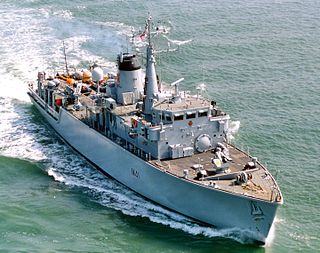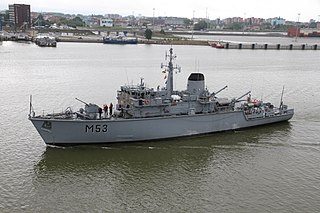Related Research Articles
Ten ships of the Royal Navy have been named HMS Lightning.
Several ships of the British Royal Navy have been named HMS Boxer, named after the competitor in a boxing match.
Three ships of the Royal Navy have been named HMS Quorn, all named after the Quorn Hunt.

The Hunt class is a class of thirteen mine countermeasure vessels of the Royal Navy. As built, they combined the separate roles of the traditional minesweeper and that of the active minehunter in one hull, but later modifications saw the removal of mine-sweeping equipment. They have a secondary role as offshore patrol vessels.
Three ships of the Royal Navy have been named HMS Atherstone after the town of Atherstone in Warwickshire, or after its hunt:
Three ships of the Royal Navy have been named HMS Brocklesby after the Brocklesby hunt:
Three ships of the Royal Navy have been named HMS Cattistock after the Cattistock hunt:
Three ships of the Royal Navy have been named HMS Cottesmore after the Cottesmore hunt:
Two ships of the Royal Navy have been named HMS Middleton after the Middleton hunt:
HMS Dulverton was a Type II Hunt-class destroyer of the Royal Navy. Launched in 1941, she saw service during the Second World War until being damaged by German aircraft in 1943 during the Battle of Leros, and was scuttled.
Six ships of the Royal Navy have been named HMS Tyne, after the River Tyne, England:
The Northern Ireland Squadron was a unit of the British Royal Navy. It was established during the conflict in Northern Ireland known as the Troubles to interdict the movement by sea of illegal arms for paramilitaries and to provide other material support for anti-terrorist operations in Northern Ireland. It existed from 1969 to 1998.
Two ships of the Royal Navy have been named HMS Ledbury, named after Ledbury Hunt, Herefordshire:

HMS Cottesmore was a Hunt-class mine countermeasures vessel of the British Royal Navy, launched in 1982 and converted in 1997 into a patrol vessel. The ship was declared surplus to requirement and put on the MoD list for disposal in 2004. In 2008 she was bought by Lithuania, along with Dulverton.

HMS Dulverton was a Hunt-class mine countermeasures vessel of the British Royal Navy, launched in 1982 and converted in 1997 into a patrol vessel. The ship was declared surplus to requirement and put on the MoD list for disposal in 2004. In 2008 she was bought by Lithuania, along with Cottesmore.
Twelve ships of the Royal Navy have borne the name HMS Mosquito, or the archaic HMS Musquito, after the tropical insect, the Mosquito:
Two ships of the Royal Navy have borne the name HMS Chiddingfold after the fox hunt at Petworth, Sussex:
Three ships of the British Royal Navy have been named HMS Oakley:
Three ships of the Royal Navy have been named HMS Bicester, named after Bicester, Oxfordshire.
HMS Southwold was a Type II British Hunt-class destroyer built for the Royal Navy during World War II. She served in the Mediterranean for a few months until she was sunk off Malta in March 1942.